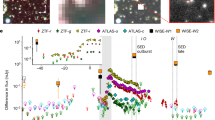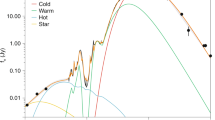Abstract
The infrared source IRc2 (ref. 1) in the star-forming region Orion-KL is generally believed to contain a massive and very young star2. Its nature and evolutionary status, however, are difficult to determine because it is hidden from direct view by a dense disk-like envelope of gas and dust. Here we report observations of infrared radiation (at a wavelength of about 2 μm) that has escaped the surrounding dust in the polar direction, perpendicular to the plane of the disk, and then been reflected towards us by dust farther away from the star. The reflected spectrum contains absorption lines of neutral metallic atoms and carbon monoxide, which we interpret as indicating a source temperature of about 4,500 K. But, given the luminosity of the source, its radius must be at least 300 solar radii—too large to be attained with the modest gas-accretion rates in existing theories of massive-star formation. Whether the infrared radiation is coming from the protostar itself or the self-luminous accretion disk around it, the accretion rate must be around (5–15) × 10−3 solar masses per year, at least two orders of magnitude greater than is commonly assumed in models of star formation.
This is a preview of subscription content, access via your institution
Access options
Subscribe to this journal
Receive 51 print issues and online access
$199.00 per year
only $3.90 per issue
Buy this article
- Purchase on Springer Link
- Instant access to full article PDF
Prices may be subject to local taxes which are calculated during checkout


Similar content being viewed by others
References
Rieke, G. H., Low, F. J. & Kleinmann, D. E. High-resolution maps of the Kleinmann–Low nebula in Orion. Astrophys. J. 186, L7–L11 (1973).
Genzel, R. & Stutzki, J. The Orion molecular cloud and star-forming region. Annu. Rev. Astron. Astrophys. 27, 41–85 (1989).
Wynn-Williams, C. G., Genzel, R., Becklin, E. E. & Downes, D. The Kleinmann–Low nebula: an infrared cavity. Astrophys. J. 281, 172–183 (1984).
Snyder, L. E. & Buhl, D. Detection of possible maser emission near 3.48 millimeters from an unidentified molecular species in Orion. Astrophys. J. 189, L31–L33 (1974).
Hasegawa, T. et al. in Masers, Molecules and Mass Outflows in Star Forming Regions (ed. Haschick, A. D.) 275–287 (Haystack Observatory, Massachusetts, (1986)).
Elitzur, M. Astronomical Masers (Kluwer, Dordrecht, (1992)).
Hasegawa, T. et al. CS around Orion-KL: a large rotating disk. Astrophys. J. 283, 117–122 (1984).
Wright, M. C. H., Plambeck, R. L. & Wilner, D. J. Amultiline aperture synthesis study of Orion-KL. Astrophys. J. 469, 216–237 (1996).
Erickson, N. R. et al. Detection of bipolar CO outflow in Orion. Astrophys. J. 261, L103–L107 (1982).
Wright, M. C. H., Plambeck, R. L., Vogel, S. N., Ho, P. T. P. & Welch, W. J. Source of the high-velocity molecular flow in Orion. Astrophys. J. 267, L41–L45 (1983).
Minchin, N. R. et al. Near-infrared imaging polarimetry of bipolar nebulae–I. The BN-KL region of OMC-1. Mon. Not. R. Astron. Soc. 248, 715–729 (1991).
Beckwith, S., Persson, S. E., Neugebauer, G. & Becklin, E. E. Observations of the molecular hydrogen emission from the Orion nebula. Astrophys. J. 223, 464–470 (1978).
Kleinmann, S. G. & Hall, D. N. B. Spectra of late-type standard stars in the region 2.0–2.5 microns. Astrophys. J. Suppl. Ser. 62, 501–517 (1986).
Ali, B., Carr, J. S., DePoy, D. L., Frogel, J. A. & Sellgren, K. Medium-resolution near-infrared (2.15–2.35 μm) spectroscopy of late-type main-sequence stars. Astron. J. 110, 2415–2424 (1995).
Greene, T. P. & Lada, C. J. Near-infrared spectra and the evolutionary status of young stellar objects: results of a 1.1–2.4 μm survey. Astron. J. 112, 2184–2221 (1996).
Draine, B. T. & Lee, H. M. Optical properties of interstellar graphite and silicate grains. Astrophys. J. 285, 89–108 (1984).
Mathis, J. S. Intestellar dust and extinction. Annu. Rev. Astron. Astrophys. 28, 37–70 (1990).
Plambeck, R. L., Wright, M. C. H. & Carlstrom, J. E. Velocity structrure of the Orion-IRc2 SiO maser: evidence for an 80 AU diameter circumstellar disk. Astrophys. J. 348, L65–L68 (1990).
Morita, K.-I., Hasegawa, T., Ukita, N., Okumura, S. K. & Ishiguro, M. Accurate positions of SiO masers in active star-forming regions: Orion-KL, W51-IRS2, and Sagittarius-B2 MD5. Publ. Astron. Soc. Jpn 44, 373–380 (1992).
Palla, F. & Stahler, S. W. The pre-main sequence evolution of intermediate-mass stars. Astrophys. J. 418, 414–425 (1993).
1. Snell, R. L., Scoville, N. Z., Sanders, D. B. & Erickson, N. R. High-velocity molecular jets. Astrophys. J. 284, 176–193 (1984).
Shu, F. et al. Magnetocentrifugally driven flows from young stars and disks. I. A generalized model. Astrophys. J. 429, 781–796 (1994).
Calvet, N., Hartmann, L. & Kenyon, S. J. On the near-infrared spectrum of FU Orionis. Astrophys. J. 383, 752–756 (1991).
Hartmann, L. & Kenyon, S. J. The FU Orionis phenomenon. Annu. Rev. Astron. Astrophys. 34, 207–240 (1996).
Gezari, D. Y. Mid-infrared imaging of Orion BN/KL: astrometry of IRc2 and the SiO maser. Astrophys. J. 396, L43–L47 (1992).
Menten, K. M. & Reid, M. J. What is powering the Orion Kleinmann–Low infrared nebula? Astrophys. J. 445, L157–L160 (1995).
Dougados, C., Léna, P., Ridgway, S. T., Christou, J. C. & Probst, R. G. Near-infrared imaging of the Becklin–Neugebauer-IRc2 region in Orion with subarcsecond resolution. Astrophys. J. 406, 112–121 (1993).
Acknowledgements
We thank S. Okumura and E. Nishihara for their kind help during the observations. J.-I.M. was supported by research fellowships of the Japan Society for the Promotion of Science for Young Scientists.
Author information
Authors and Affiliations
Corresponding author
Rights and permissions
About this article
Cite this article
Morino, JI., Yamashita, T., Hasegawa, T. et al. Reflected infrared spectrum of a massive protostar in Orion. Nature 393, 340–342 (1998). https://doi.org/10.1038/30678
Received:
Accepted:
Issue Date:
DOI: https://doi.org/10.1038/30678
Comments
By submitting a comment you agree to abide by our Terms and Community Guidelines. If you find something abusive or that does not comply with our terms or guidelines please flag it as inappropriate.



